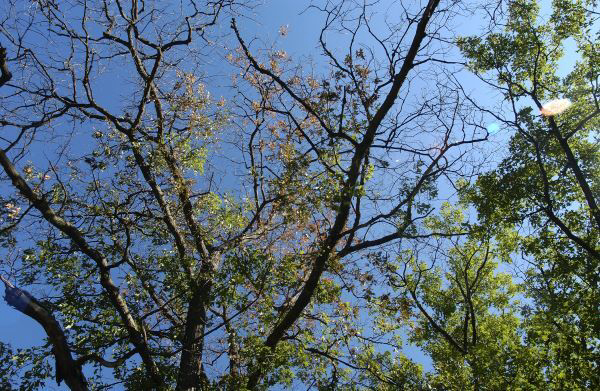Delay Pruning Until Mid-July to Help Keep Oak Trees Safe from Deadly Fungus

To stop the spread of oak wilt, a fungal disease that can kill red oak trees within weeks, the Michigan Department of Natural Resources is urging homeowners not to prune any oak trees from April 15-July 15, the period of highest risk.
During that time period, sap-feeding nitidulidae beetles can transfer spores of the fungus from infected trees to healthy ones that have wounds. Risk is highest from mid-April to mid-July, and recent research at Michigan State University indicates that in Michigan, oak infection risk peaks in May and June.
Oak wilt also can spread when people move firewood cut from infected trees, and from tree to tree through connected root systems.
“It is important to prevent infection because this disease can kill trees very quickly,” said Simeon Wright, forest health pathologist in the DNR’s Forest Resources Division. “Oaks in the red oak family can die within weeks.”
If you suspect a tree has died of oak wilt, you can slow the spread of disease by burning it onsite, chipping it or debarking it before April 15. Once wood has been dried for longer than a year and/or all the bark loosens, the firewood can no longer spread oak wilt. If you choose to burn diseased trees onsite, always follow local ordinances and check the fire conditions prior to burning.
If your oak tree gets damaged during the high-risk period, immediately cover all wounds with tree-wound paint or latex-based paint. Painting tree wounds is not recommended for other tree species as it can reduce healing.
Oak wilt is common in the Lower Peninsula. It also has been identified in Menominee, Dickinson, Iron and Marquette counties in the Upper Peninsula. Trees in the red oak family – including black oak, northern red oak and northern pin oak – are more susceptible. These trees all have leaves with pointed tips. Trees in the white oak group have rounded leaf edges and include white oak, swamp white oak, and bur oak. These trees are better able to block spread of the disease, preventing rapid death.
Symptoms of oak wilt most often appear from late June until September. Affected trees suddenly wilt from the top down, rapidly dropping leaves, which can be green, brown or a combination of both colors. Left untreated, oak wilt will continue to move from tree to tree through grafted root systems, killing more red oak over an increasingly large area when oaks grow close together.
To minimize the risk of oak wilt infection caused by logging damage, the DNR restricts cutting and other activities that could wound oak trees on state forest land from April 15-July 15. The DNR recommends private forest landowners exercise caution during this period and, whenever possible, delay harvests in oak forests until after July 15.
If you suspect a tree has oak wilt:
- Report infections using the oak wilt interactive map.
- Email a DNR forest health program staff to ask a question.
- Michigan State University’s Diagnostic Clinic also can verify oak wilt infection. Find instructions online or call 517-355-4536.
- Learn more about the disease at michiganoakwilt.org.
- Learn more about invasive species in the state, including oak wilt.
- Get help from an oak-wilt qualified specialist found in the Oak Wilt Qualified Specialist Directory.





